

Through computerized tomography imaging and the use of other diagnostic technologies, Dr. Palmer can assess the shape, position, and health of your cranial, facial and jaw structures.
Problems to look for are things such as an underdeveloped upper jaw, an underdeveloped bottom jaw, or a bottom jaw that is overgrown (underbites and overbites), jaws that are too narrow, or jaw joints that are compressed or damaged.
Physiologically based orthodontic therapy enables Dr. Palmer to alter the top jaw to the proper size and then she can get the bottom jaw into a relaxed physiologic bite position.
Dr. Shauna Palmer, Dentist at Health & Beauty Dentistry, West-Kelowna:
"Regardless, people have many questions about adult braces. Below, we'll answer those questions the best we can."

